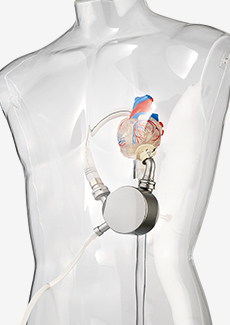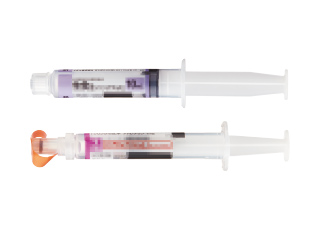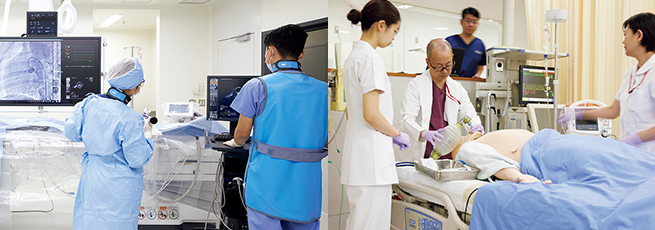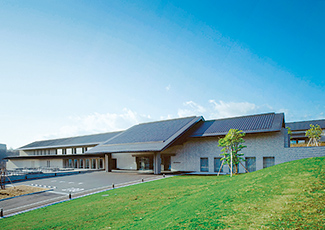 Top
TopAt the time of Terumo’s founding in 1921, however, Japan’s supply of thermometers from Germany, the U.K. and the U.S. was suddenly cut off with the outbreak of World War I. An initiative to manufacture high-quality thermometers domestically in Japan was launched, with Dr. Shibasaburo Kitasato as one of the founding members. This was the beginning of Terumo.
A small factory existed that produced mercury thermometers with a red line core. Terumo used this as a prototype and set about improving the accuracy and manufacturing quality. Irregularities in alignment resulting from sudden cooling during manufacturing caused inconsistent readings, but such challenges were overcome using unique technology.
Soon, Terumo began to receive recognition both within and outside Japan for its thermometers. Once considered instruments for hospital use only, they entered widespread household use as the 1920s progressed. As a result, now-common behaviors such as staying home when we have a fever and managing our health by monitoring our temperature eventually permeated through society and into people’s daily lives.

(1923 German type. Standard glass thermometer
that served as a base for measuring temperature
accurately.)
Everyone has seen a syringe. They are common medical devices used for giving vaccinations and administering medication. Today, disposing of syringes after a single use is the normal practice, but that only became the case over the last half century. Until then, syringes were reused following sterilization. This led to the spread of hepatitis and other diseases. To solve this problem, Terumo started developing single-use disposable syringes in the 1950s.
To succeed, one of the challenges Terumo had to overcome was the major issue of sterilization. Unlike conventional syringes made of glass, high-temperature sterilization after production was unsuited to the plastic parts of disposable syringes. Aided by the advice of research institutions and experts outside Japan, Terumo achieved the practical use of a low-temperature gas sterilization method suited for medical instruments, and in 1963 became the first company to market disposable syringes in Japan.
Terumo went on to develop soft bag containers for storing blood for transfusion and infusion fluids. Since these products were designed in a way that did not require needles during use, they helped reduce the risk of blood contamination and the spread of infection.

The first disposable syringe in Japan

The first blood bag and
transfusion set in Japan
After establishing such modern healthcare norms as household use thermometers manufactured in Japan and disposable syringes, Terumo’s next challenges involved supporting and sustaining human biological activity. Terumo launched its first product in this field in 1977: a dialyzer which was used to remove excess waste and fluids from the blood of patients with severe kidney disease. Terumo continued enhancing its dialyzer technology, eventually creating the world’s first porous hollow-fiber oxygenator that substitutes for the patient’s lungs to exchange gas during surgery. ECMO (extracorporeal membrane oxygenation) also has roots in this technology, and has been used to treat respiratory failure caused by COVID-19, giving hope to patients fighting this infectious disease.
Terumo then went on to develop an artificial heart, based on the centrifugal pump technology of the heart-lung machine which is the part of the cardiopulmonary bypass system that takes over the role of the heart and lungs during cardiac surgery. A technology that helps prevent dangerous blood clots forming was also adopted. An implantable left ventricular assist device was then launched with a strong focus on the durability and reliability needed to keep such an essential organ as the heart working non-stop with minimum damage to the blood.
As always, our goal remains the same: to create new technology that benefits and saves as many lives as possible – Terumo’s belief has not changed and it never will.

First porous hollow-fiber oxygenator in the world

Extracorporeal membrane
oxygenation (ECMO)
Implantable left ventricular
assist device
A strong will to support medical professionals – this is carried through all of Terumo’s products and services. In product development, superior usability is pursued to offer reassurance to medical professionals so they can focus on taking care of patients. Through technologies such as a closed infusion system for securely connecting syringes and intravenous devices, prefilled syringes designed for safer healthcare provision and products designed to protect medical professionals from exposure to anticancer drugs, Terumo supports frontline medical professionals in their fight to save lives. Terumo also offers the practical training required in various medical fields. In addition to helping medical professionals to understand the correct usage of devices and to acquire new skills and techniques, Terumo grasps the needs of such professionals and applies this knowledge to develop or improve products, simulators and training programs. Terumo will keep advancing together with medical professionals as it embarks on the next stage of its journey.

Closed infusion system

Prefilled syringe

Offering training sessions for medical professionals at Terumo Medical Pranex

Terumo Medical Pranex
